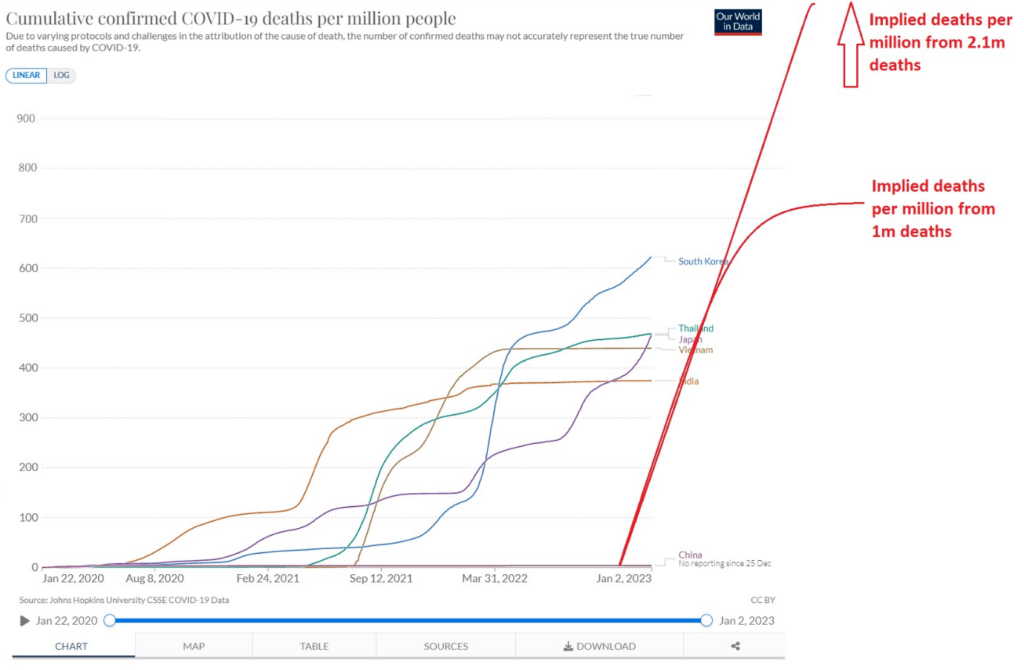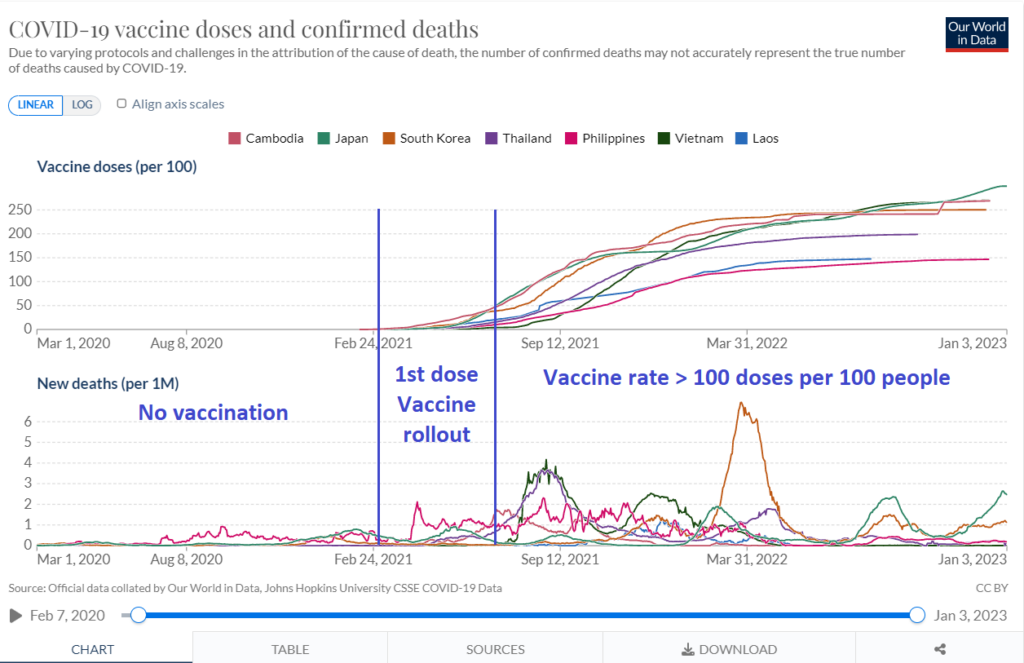Several of the articles I’ve written for the Daily Sceptic have come about from conversations I’ve either had or overheard. Today’s is no different. This time it was my mother-in-law saying, with some foreboding, that: “Things are getting very bad in China. They say 1 million people are going to die!” And, indeed she’s right, this is what much of the mainstream media are saying.
I don’t expect my mother-in-law has much idea what the population of China is. About 1.4bn, is the answer. Neither would she know how many people die annually in China in a normal year — why would she? It’s about 11m. Whilst my mother-in-law can be excused for not easily being able to put these figures in context, the same cannot be said for the BBC, CNN, Fox, the Telegraph, MSN, Bloomberg, Reuters, the Washington Post or the New York Times.
Cindy Yu, a journalist I have a lot of time for, wrote a piece in the Spectator that attributed the 1 million deaths figure to an un-named Hong Kong university. But her article, like so many others, made no attempt to contextualise this number. I think my mother-in-law can be forgiven for having failed to do so also.
Since Cindy Yu’s Spectator article we’ve had Gordon Chang in the Telegraph telling us that 2.1m may die. Gordon’s got a book to flog titled The Coming Collapse of China, so you can understand he’s not a man to play down China’s local difficulty. Then, as this game of ‘top trumps’ really heats up, we’ve had Amol Rajan on the BBC Radio 4 Today programme on January 5th 2023, during a discussion with Professor Rana Mitter of Oxford University, no less, a China expert, speculating that deaths would be in the tens of millions!
Let’s see if we can shed a little light on the figures.
Data from the UN suggest that 7.8 people per 1,000 Chinese die every year. It seems low to me but let’s go with it. If a million people were to die of Covid this year, then that figure would go up to 8.5 per 1,000. Of course, just like everywhere else, the profile of those 7.8 per 1,000 dying in a normal year tend to be very elderly, frail, with multiple comorbidities. Well, that extra 0.7 person per 1,000 dying will also tend to be very elderly, frail and with multiple comorbidities. Think of your village, town, city, suburb, whatever: if 8.5 people per 1,000 died one year rather than the usual 7.8, would you notice? Maybe, if you were an undertaker, you’d see a very busy spell, likewise for the hospitals. But for the man on the Guangdong omnibus, would he notice anything?
But how credible are these figures, 1m, 2.1m, 10m? You instinctively know that if it’s made the papers and it’s come from some Fergusonesque modeler with a pre-disposition to over-dramatise, it’s bound to represent an unlikely worst-case scenario, or in the case of the BBC’s Amol Rajan, simply plucked out of the air. Let’s apply the ‘sniff’ test to these numbers. Do any of them smell right?
If there were 1 million Covid deaths in China during this wave, that would mean about 714 deaths per million of population. 2.1m deaths would mean 1,500 deaths per million, and 10 million would mean over 7,000 deaths per million. Nowhere in the world has hit this level of deaths after three years and multiple waves.
Figure 1 shows the fatality rate in China’s neighbours, the U.S. and the U.K., according to Our World in Data.

The average cumulative fatality rate after three years of Covid in the Asian states is about 500 per million. The implied China fatality rate from 1 million deaths would put China ahead of its neighbours. The figure looks to be on the high side, but credible. The 2.1 million deaths would put it three times higher. The fact that China is now battling the relative pussycat that is the Omicron variant, rather than the more full-throated varieties that India dealt with back in 2021, reinforces my view that China is more likely to be at the lower end of the Asian range than the top. My guess would be in the range of 500,000 to 700,000 deaths.
The 2.1 million forecast of Gordon Chang looks like scaremongering. Figure 2 gives you an idea of how far off the scale the 2.1 million figure would be. Why should China buck the regional trend? Is Chinese society so very different from Vietnam’s? If the cumulative rate in Vietnam is 439 per million, and India’s 374 per million, why should China’s be significantly higher? Vaccines?

Defenders of the vaccines may claim that China’s failure to vaccinate its 1.4 billion people with mRNA vaccines makes it more vulnerable than the neighbouring countries. However, looking at figure 3 we can see that after these countries had injected more than one dose of vaccine per person, rather than the fatality rate reducing, it accelerated.

It doesn’t seem that the Chinese need to worry over-much about not having deployed the mRNA vaccines.
No one trusts the Chinese data, so it seems likely we’ll never know how the relaxation of measures will work out. There’s clearly a fine line the Chinese Community Party (CCP) needs to walk. Overdramatise the deaths and people will feel betrayed by the relaxing of rules. Allow a bit of openness and by the end of the Chinese New Year holidays the people will realise that they can’t identify any significant difference to normal, and they’ll see what a paper tiger Covid truly was and wonder what they’ve just spent three years locked up for. Either way, it looks like a tricky task for the CCP to spin this to its advantage.
Think back to May 2021, the media went into a frenzy over deaths in India, while at the same time the official fatality rate in Poland was about seven times greater. The media is a lot more interested in shedding more heat than light.
Cindy Yu’s piece in the Spectator tells us that many of the big cities already seem to be coming out of the latest Covid wave. Traffic is up, cinemas are reopening. It sounds like the people are beginning to make their own risk assessment. Maybe the Swedish approach has won out after all.












To join in with the discussion please make a donation to The Daily Sceptic.
Profanity and abuse will be removed and may lead to a permanent ban.
In short, no. This storm in a tea cup will not speed up the the demise of the BBC. The establishment know how powerful the BBC can be at spreading half truths and Propaganda to help their causes. The BBC coupled with Ofcom are their most effective tools.
I’m all for scrapping this. I hate the arrogance of the license fee. It’s explicitly for funding the Beeb, but the stipulation that watching any incoming live channel makes you subject to this charge is laughable.
If we stop finding it, I’m sure gates et al would step in. They like owning media companies. Yet at least the money trail would be overt and so would their bias.
funding…
damn autocorrect
Yes, I thought that the conservatives were a bit wobbly on the BBC fir a while there, but their role in the covid scam seems to have cemented their position at least fir a while.
I’m afraid that the TV Tax will never disappear. It may transform into being taxed at source, but I can’t conceive of a time when the BBC will ever go subscription. This isnt just about covid lies or propaganda. It covers wide ranging issues, from Net Zero propaganda to breaking down National pride to so called ‘anti-racisim’ (or as it should be known anti white racisim) etc etc. This is not a battle that the spineless tory government are willing to fight, nor have they got the power to take on the civil service, which seems to have more power than any government, or that we give them credit for. The BBC is here for good unfortunately, whether we like it or not.
My TV tax has disappeared – I simply don’t pay it.
Correct.
BBC Ltd was originally a private company owned by a consortium of radio and TV receiver manufacturers. They paid for the service by incorporating a fee in the selling price, but they just were not selling enough sets fast enough to cover increasing costs.
Radio transmission are a public good (in the economics sense) therefore the licence fee was, at first, the only way to provide enough funding for BBC Ltd. It is in fact a receiver licence not a fee per se to watch the BBC, but a licence to receive ALL broadcast radio transmissions. At the time of course there was only the BBC.
War came and the consortium saw BBC Ltd as non-money making, so were happy to hand it over to Government.
However, post-war, it became clear that using sponsorship and commercial advertising (as in the USA, and later ITV in the UK) resolved the public good issue.
The justification to keep the licence fee, and opposition to commercial ITV at the time) was the Government and the clever folk, would lose control of what the population might see and hear – particularly important in times of national emergency.
No Government will willingly give up control of the BBC. It could be achieved easily by introducing encryption and subscription fee, then privatising it. It should have been done by Thatcher in the 1980s along with other State owned loss-makers, and the NHS, but…
The Prime Minister and his government, who I don’t trust, have announced this immigration policy. It won’t work because the civil service whose job it is to make it work, and the judiciary whose job it is to adjudicate legal challenges to the policy, and the Border Force whose job it is to execute the policy are largely made up of left leaning overpaid metropolitan social justice warriors like Lineker who think it is ok for them not to do their job if they disagree with the policy that their job requires. So it’s doomed to failure. I’m just hoping that the BBC and Lineker self immoliate (figuritively speaking) in the process.
Or even literally…? That picture from Vietnam times was powerful. Imagine Lineker going for that ..
I’m not that keen on the smell of napalm in the morning…it reminds me of Victory Vs.
It looks like the downvoters don’t know what figuratively means.
Listen …. The F – – king Boats won’t stop until we stop them by overthrowing ALL of the Double Eyed political Barstewards around the world who continue to hold our feet to the fire 🔥!!!!!…
‘According to the latest estimates by the Office for National Statistics (ONS), net migration from overseas to the UK in the year ending March 2020 totalled 313,000 – the highest in four years and approaching the all-time record of 331,000 in the year to March 2015.’
Net migration into Britain has averaged about 250k per year since 1998.
Blair’s Britain has been propped up by 4 ‘O’ level nincompoops like Gary Winston Lineker who clearly has no idea of the generosity this country has shown since 1997 and is still showing to real refugees:
“….bespoke humanitarian schemes” for Ukrainians and Hong Kong British National Overseas (BNO) accounted for 45% of the increase in visas granted to non-EU citizens between 2019 and the year ending June 2022.’
‘The new data show immigration of 1.1 million in the year to June 2022, with emigration of 560,000, leading to net migration of 504,000.’ Nov 2022
https://migrationobservatory.ox.ac.uk/press/net-migration-rises-due-to-ukraine-and-bno-schemes-as-well-as-post-covid-rebound-in-international-students/
Well done ‘Winston’. By your efforts, the whole country now sees what Blair/Brown did to us, which the hopeless conservatives have failed to undo.
Oh….and well done also for adding half a million viewers to match of the day in your absence.
Rumbled……
Britain is like a septic tank, all the thick nasty stuff coming in stays in an unpleasant layer at the bottom whilst the cleaner, brighter stuff flows off down-stream and thence overseas.
Ok then so lets just allow all the boats and we can build a ring road around the Orkneys. How many people do the social justice twerps think can comfortably live in this country? 80 million? 100 million? 120 Million? And ofcourse there will be no room for cars by then and we will all be offered a bicycle if we hand in our vehicle.
I don’t think this will end the BBC, but I can foresee a switch to subscription sooner rather than later. There’s no way ‘neutrality’ can work there. The entire mindset is left wing on every level. Conservatives and libertarians don’t want to work there.
As it stands, if everyone’s licence fee is switched to subscription, most people will continue to use the BBC. When it comes to the end of the licence year, most people will pay up the same as usual and type in their former licence – now subscription – number when they access the BBC on their TV.
People who currently refuse to pay the licence fee won’t subscribe, so no change there. People who are using the BBC without a licence will stop receiving it, so there’s no legal issue. Capita will no longer need to be employed to send goons around to people’s houses and the courts won’t have to waste time chasing up people who don’t pay the licence, so that’s money saved.
The BBC will remain under the auspices of the WEF-aligned Ofcom and can carry on its campaign of lies to undermine British culture, but at least if you don’t like it, you won’t have to pay for it. Maybe it would be a good moment for GB News to have a chat with Daily Wire in the USA and other organisations about creating a subscription network for those who want a different source of media.
I was pleased to see there was no solidarity from the oval ball commentary team at today’s 6 Nations match. I have always thought Rugby Union was altogether more classy than soccer.
Yes they were and then they weren’t. They were pretty quick to take the knee. Vomit inducing really for an ex school and club player. And then of course there is this…
I once entertained some clients at a Rugby League match. Northampton v London Irish, I think.
It was as if time had stopped.
I mean Union, don’t I?
You do, indeed
“Why the Lineker Saga Will Accelerate the BBC’s Demise”
Well it would be nice to think that some good might come from this sorry little soap opera, filled as it is with thicko,
woke touting, grotesquely overpaid inconsequential has beens.
Imagine if the first few barbarian invader dinghys had been sunk.
The problem would have gone away.
But we live in corrupt and decadent times.
Christ, I’ve just googled him and he’s only 6 weeks older than me.
He looks like a little old man who smells of stale urine.
If the beeb sold advertising, they’d be happy with the BARB figures.
You only need a TV licence if you watch live broadcast TV (air, satellite, internet) or use iPlayer. So if you watch ITV on catch-up, stream Netflix, etc. you don’t need a licence.
Rather than whinge about the BBC partiality I cancelled my licence years ago.
The comments at the linked Guido Fawkes are very funny. 🤣
The Telegraph’s headline this morning talked about the BBC giving in to the crisp salesman. They should take account of the 25% ish increase in viewers on Saturday night in the absence of the smug thicko and think again
If Lineker is re-instated then that means he and all other BBC employees must now be able to say whatever they like on other platforms. Toby Young has even said he thinks Lineker should be able to speak freely. ——–So, if that is the case then all BBC employees and presenters should be able to speak freely on all manner of topics. But imagine if Lineker were to say “Global warming is a load of rubbish” or “Vaccines don’t work and Lockdowns were a joke”. ————-The BBC does not allow any questions to be asked about the climate issue. They have simply decided that everything about it is all true, and they have really just become climate change activists, so what would be the reaction of the BBC if Lineker or any other presenter were to be saying things like that? This is the problem that the BBC has created for itself. It wants to try and claim it is “impartial” but it is NOT. It has a world view all to the progressive left. So then when something like this happens with Lineker they don’t know which way to turn. Because they realise that the government and all the license fee payers who do not subscribe to the world view of the BBC and Lineker think that as the state broadcaster it should not be blatantly spouting this social justice stuff. Oh what a pickle. —-The lesson then is that you either let people speak freely or you don’t. But they must also be allowed to speak freely on issues such as climate and covid, which BBC currently won’t allow. SKY do something similar but people are not forced to pay for SKY.
To paraphrase a famous late PM the trouble is the BBC (like the NHS) is a State within a State.
Time to withdraw funds if you haven’t already done so?
Will sufficient people find a teeny weeny bit of backbone and stop paying their licence fee to fulfil the phenomena of companies going broke by going woke?